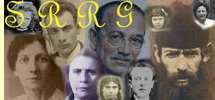

The Chasidic Group of Kopyczynitz
by Abraham Heshel
Grand Rabbi Isaac
Meir Heschel, the founder and the first Rebbe of Kopyczynitz, was born
in 1862 in the Ukrainian city of Medzibush.
In 1881 he married the daughter of his mother’s uncle, Grand Rabbi Mordechai
Shraga Friedman of Husyatin. Isaac
Meir lived in the regal court of his father-in-law for the next thirteen
years, during this time he attracted scores of followers who flocked to him
for advice and support.
In 1894 upon the
death of his father-in-law, Rabbi Isaac Meir accepted the invitation of the
inhabitants of the nearby town of Kopyczynitz to settle in their town and
thus become the Kopyczynitzer Rebbe.
Rabbi Isaac Meir soon attracted hundreds of followers from throughout
the region, and as far away as Sered, Bukovina. He became renown as not only
as a “Wunder Rabbiner” a miracle worker, but also as citadel of kindness
and support. Combining the famed regal way of the Friedman dynasty of Ruzhin,
with the equally famous “Love of Israel”of his Heschel ancestors of Apta
and Zinkov, he soon became one of the most respected Chasidic Masters in
Galicia. Perhaps unique among his peers was his remarkable ability to
communicate and forge close relationships with non Religious Jews, a trait
that would be prevalent with his successors as well.
In 1914 with the
Russian invasion of Poland, Rabbi Isaac Meir along with his family and some
of his followers fled to Vienna, Austria where he managed to reestablish his
court, albeit on a smaller scale. Annually he would return to Galicia and
visit his followers in various cities, including a stay in his court in
Kopyczynitz. On the first day of Rosh Hashana, September 10th
1934, Rabbi Isaac Meir died in Vienna, and was succeeded by his eldest son
Grand Rabbi Abraham Joshua Heschel.
Like his father
before him, Abraham Joshua was venerated by Chasidic and non-religious Jews
alike, his home was a center for constant charitable activities, and as he
personally attested some years later, he never slept a night with money in
his possession, having always distributed every last Groschen to the
destitute.
In 1938 following
the German Anschluss, he was arrested by the Nazis and later forced to
clean the street with a toothbrush, yet he refused to leave his followers.
The following year when the vast majority of his followers fled or had been
deported, he finally agreed to escape to the United States, where he soon
reestablished his court in the Lower East side of New York City.
In July of 1968,
Rabbi Moshe Mordechai formally assumed the position of Kopyczynitzer Rebbe,
continuing the tradition of charity and kindness, he soon became a father
figure and mentor to hundreds of Jews. American raised and thus fluent in
English, the young Rebbe attracted a large number of new American followers
to his flourishing court, including many with a secular background.
On March 29th 1975, to the shock of the entire Chasidic world, Rabbi Moshe Mordechai died suddenly of a cerebral hemorrhage, leaving thousand of followers and supporters in deep mourning. His followers refused to entertain the possibility of accepting another candidate as their Rebbe, waiting instead for the young orphans to grow up. Many chose to consult his widow, the Rebbetzin, a noted educator in her own right for her advice and her blessings. Shortly after his death the death of her husband, the Rebbetzin founded a free loan fund named Tiferes Moshe Mordechai in his memory. At the same time family members in Israel founded a free loan fund which they named Darkei Moshe.
In 1999, together with the assistance of his Mother
and older brothers, the youngest son, Rabbi Avraham Heschel founded Chasdei
Moshe-Kopyczynitz an outreach organization dedicated in memory of the
late Grand Rabbi. In the fall of 2000, the Brandler Institute of Chasidic
Thought, a think tank devoted to bringing a greater understanding of
Chasidic culture to the secular society was inaugurated as a division of Chasdei
Moshe-Kopyczynitz. A number of lectures and social events have been
scheduled for the winter and spring of 2001. The latest developments have
delighted the hundreds of followers of the Kopyczynitzer Chasidic group, who
are eagerly supporting all efforts that are helping insure the continuity of
their group.
This page is hosted at no cost to the public by JewishGen, Inc., a non-profit corporation. If you feel there is a benefit to you in accessing this site, your JewishGen-erosity is appreciated.
Last updated 06/21/03 by ELR
Copyright © 2003 SRRG